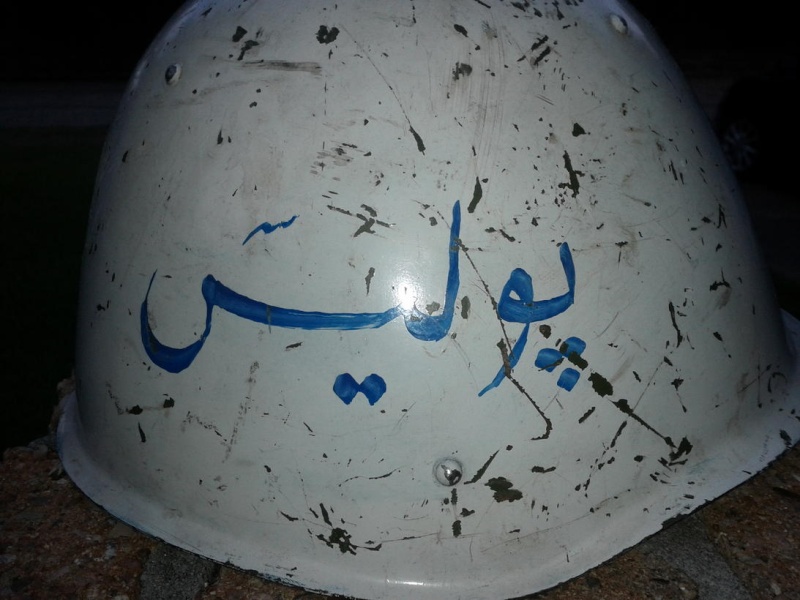A history of Ssh-68 helmet's in Afghan National Police service in Kabul as told by photos.
 22 December 2001
22 December 2001: RENEWED AFGHAN POLICE Afghan police in helmets and new uniforms stand guard during the swearing- in ceremonies to officially form the interim administration on in Kabul, Afghanistan. Photo by Amir Shah
This is the earliest photo I found of ANP wearing Ssh-68s, almost immediately after the ANP was formed. The men in the foreground wear grey painted Ssh-68s with "پولیس", Pashto for "Police" stenciled in black paint visible on the right side along with dress uniforms with sashes and gold shoulder boards and cords, and red accents, which I belive are reserved for the ANP Honor Guard. In the background are men wearing plainer uniforms. They wear white helmets with dark text on the side. At the very least this shows the grey helmets are for formal or ceremonial use, and the white helmets are for regular policemen or everyday use.
 10 January 2002
10 January 2002: British Paratroopers from D Company 2nd Battalion, based in Colchester, England, who are part of ISAF, the International Security Assistance Force for Afghanistan, shakes hands with Afghan police officers, before their first joint patrol of the Afghan capital Kabul, . ISAF, currently only a few hundred soldiers, will eventually contain several thousand troops from over ten mostly European countries. Photos by Brennan Linsley
 10 January 2002
10 January 2002: Kabul Afghanistan: an Afghan Police Man Looks on As He and His Colleagues Join British Paratroopers During a Patrol in the Center of Kabul Thursday 10 January 2002. Photo by Anja Niedringhaus
These policemen wear white helmets with "Police" stenciled in black on the right side of the helmet, and "پولیس" on the left. The use of white helmets out on patrol reinforces they were for everyday use of regular policemen.
 14 January 2002
14 January 2002:Kabul Afghanistan: a German Soldier Peers From a Truck During a Joint Patrol with Afghan Policemen Through Kabul Monday 14 January 2002 the First Joint Patrol Between German Soldiers and Afghan Police Started Today. Photo by Anja Niedringhaus
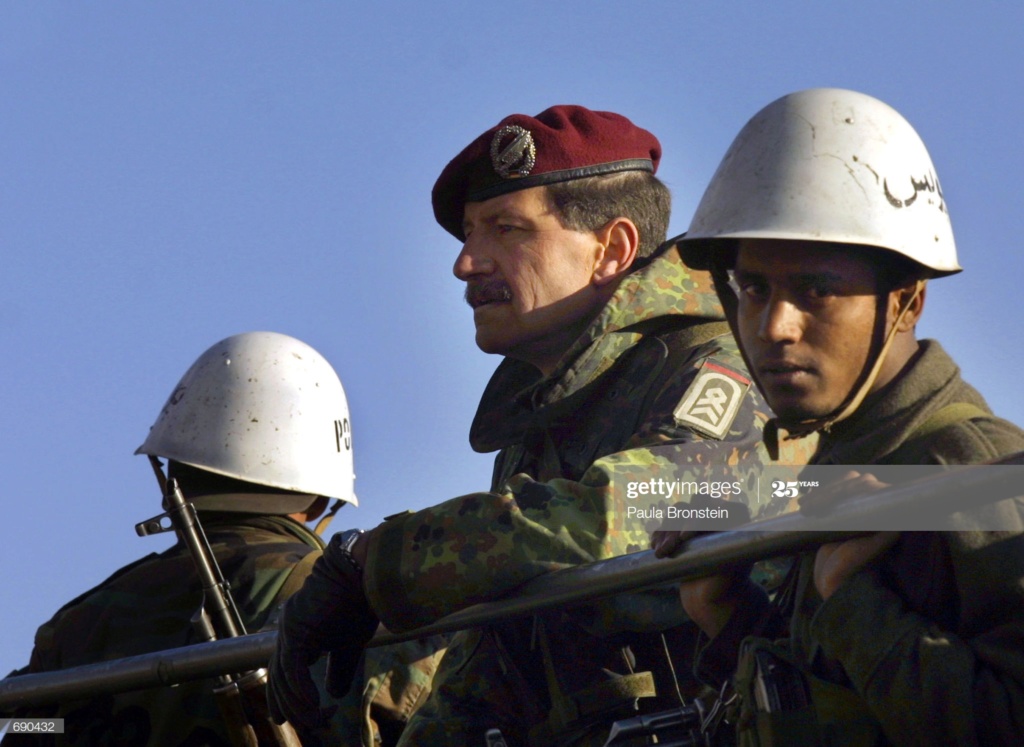 14 January 2002
14 January 2002:A German soldier and Kabul police patrol the city of Kabul January 14, 2002 in Afghanistan. German troops are in Afghanistan as part of the International Security Assistance Force (ISAF) that will total 5,000 troops from 18 countries by mid-February. Photo by Paula Bronstein.
Again white helmets are seen on patrol. These men have "police" stenciled in black on their right, and "پولیس" stenciled on their left. Although their helmets are quite dirty, in the first photo it appears the area behind the text is a more greyish off-white. This is especially apparent on the leftmost man's helmet. This may indicate earlier markings were painted over, either because of a change in markings, or an error when applying markings. In the second photo it appears the marking was stenciled with a brush, as there are several spots where the letters bulge in or out, or are incomplete or smudged, as if the stencil was nudged by the paint brush. In the third photo the man on the left is wearing his helmet backwards, causing the markings to be displayed in reverse, with "Police" on his right, and "پولیس" on his left. The Ssh-68 has very little difference between the front and back. The chinstrap is a two point chinstrap attached at the midpoint, and the interior pads are symmetrical. The only real difference is the rim is about an inch or so higher in front.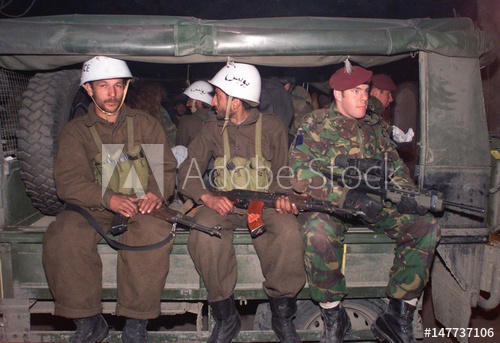 17 January 2002
17 January 2002: British troops are on a joined night patrol together with Afghanpolice in Kabul early January 17, 2002. British troops in Kabul areleading the ISAF (International Security Assistance Force) in theAfghan capital. ISAF currently has about 1,400 of the 4,500 foreigntroops due to assist Afghan security forces in keeping peace in Kabul. Photo by Wolfram Steinberg.
 17 January 2002
17 January 2002: POLICE A British paratrooper, right, gives chewing gum to an Afghan policeman during a joint night patrol of British troops and Afghan Police in Kabul early Thursday morning, . The British troops in Kabul are leading the ISAF (International Security Assistance Force) in the Afghan capital. Photo by Wolfram Steinberg.
Once again the man on the streets wears a white helmet with "police" stenciled in black on their right, and "پولیس" stenciled on their left. 24 January 2002
24 January 2002:AFGHAN POLICE Afghan Police wear new helmets as they are transported to their posts in Kabul, Afghanistan, . Afghan police and foreign troops from the International Security Assistance Force, ISAF, are the only ones allowed in the capital to carry firearms. Photo by Bullit Marquez.
The men wear the same stenciled white helmets, two men in the back wear theirs backwards. 29 January 2002
29 January 2002:A heavily-armed Afghan policeman checks a car's contents in the centerof Kabul on January 29, 2002. The Afghan Interim administration'sMinistry of Interiar Affairs has launched a mass police action in Kabulto restore security in the Afghan capital. Police check cars forweapons and have ordered drivers to remove tinted windows. Photo by Oleg Popov.
 29 January 2002
29 January 2002:SHADES An Afghan police officer rushes to the next vehicle after confiscating the sun visor from a taxicab at an intersectionn in Kabul, Afghanistan, . Police surprised motorists Tuesday by setting up roadblocks around the capital to confiscate car shades and scrape off dark tints on their windshields in a move to deter rising criminality. Photo by Bullit Marquez.
Both men in the foregrounds wear the now familiar white helmets backwards. This could be intentional, as it allows them to angle the helmet further backwards on their head than they would be able to if they wore it forwards. Wearing helmets backwards for this reason has been a common practice at times in various militaries.  13 February 2002
13 February 2002: Afghan police armed with a rocket luncher and heavy machine guns guard the street to Kabul's International Airport, 13 February 2002. Heavyly armed Afghan police tighten security around the ariport as the first trip of the Afghan Muslim pilgrime left for the Hajj, the biggest Muslim gathering in Saudi Arabia. Photo by Jewel Samad.
 15 February 2002
15 February 2002: AFGHAN POLICE Afghan police secure the area of the entrance to Kabul airport, background, . Afghan Minister of Civil Aviation and Tourism Abdul Rahman was attacked and killed at the Kabul airport late Thursday by a mob of Muslim pilgrims enraged over flight delays to Mecca, the interim government confirmed Friday. Photo by Lefteris Pitarakis.
There is really nothing left to say about these white helmets with black stenciled letters, I am just including these photos to further cement the dates and regularity of this design. 15 February 2002
15 February 2002: An Afgan police man watches a member of Kabul United throw a soccer ball February 15, 2002 in Kabul's Olympic stadium. The International Security Assistance Force (ISAF) soccer team kicked off against Kabul United in the Game of Unity match February 15, 2002 in Kabul's Olympic Stadium. The stadium, once the site of public executions, was the venue for the game, and was attended by at least 40,000 people. ISAF won the match by a score of 3 to 1. Photo by Natalie Behring.
This policeman again wears his helmet backwards. It does not have the stencil breaks seen on the other helmets, so it was either painted freehand or the stencil breaks were carefully touched up. 20 February 2002
20 February 2002: Afghan police patrol move along the street of capital Afghanistan, Kabul. . Afghan police, with an international peacekeeping force, are responsible for security in Kabul. Picture in truck window is of assassinated northern leader Ahmad Shah Massoud. Photo by Mikhail Metzel.
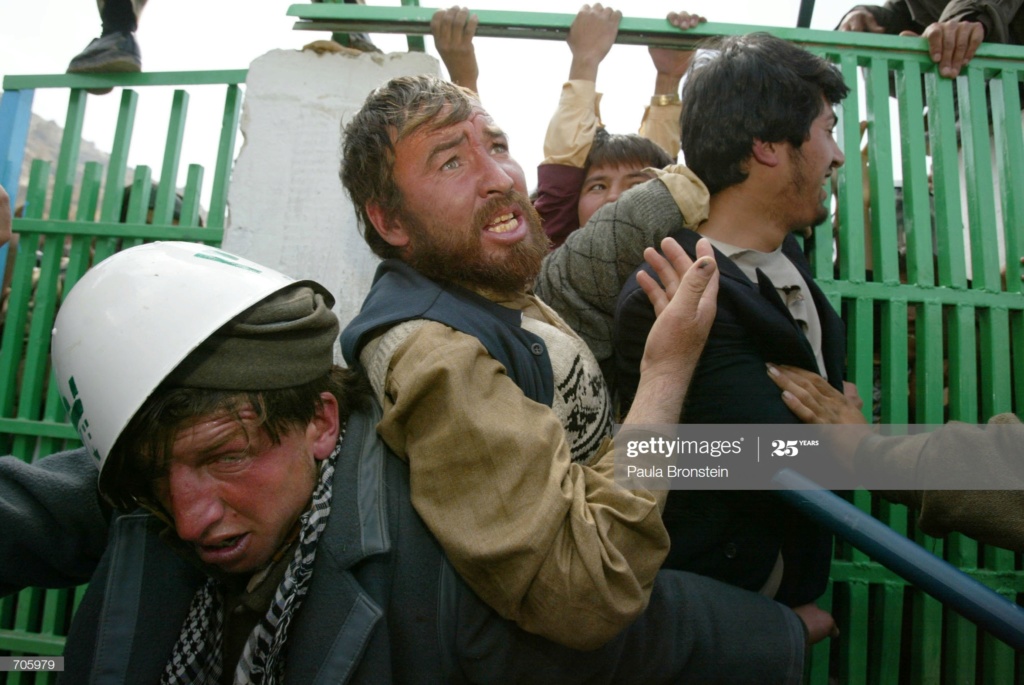
 21 March 2002
21 March 2002:Attempting to control the crowd trying to get through the gate, Afghan police officers beat back Muslim men rushing to pray at the Jonda pole March 21, 2002 outside of the Karti Sakhi Shrine in Kabul, Afghanistan. The Jonda pole is raised for 40 days as a symbol of a renewal of life to celebrate the New Year festival of "Nowruz," which heralds the start of spring. The celebration was forbidden during Taliban rule. During the three-day festival, families visit graveyards, and have picnics. Photos by Paula Bronstein.
These men still wear white Ssh-68s with "Police" and "پولیس" stenciled on them, but in green paint, This text is painted with new stencils, the letters are larger, the Pashto "پولیس" is blocky instead of the earlier script, and the stencil breaks of the English "Police" are placed differently. The "P" has no hole in the center, just a straight line, the break in the "O" is now vertical instead of horizontal, the break in the "L" is now horizontal rather than vertical. The text may have switched sides on one or both of the helmets, with "پولیس" on the wearer's right, and "Police" on the wearer's left, but it is hard to tell for certain from these angles if either man has his helmet on backwards. The helmets appear to be freshly painted, with less dirt and fewer chips and scratches than on earlier helmets. In the second photo the man on the left has a few green spots below the word "Police" these may or may not be intentional, the left one looks like it may be a five pointed star. On the right edge of the photo we see the beginning of the Ssh-68's replacement, with a white PASGT-style helmet.  18 April 2002
18 April 2002: Afghan women pass behind a police line as they try to catch a glimpseof former Afghan king Mohammad Zahir shir at Kabul airport April 18,2002. Afghanistan's ex-king Mohammad Zahir Shah arrived home Thursdayafter 29 years of exile in Italy, carrying on his frail elderlyshoulders hopes for a sea change in the nation's warring politics. Photo by Peter Andrews.
Again we see the pairing of fancy uniforms with grey helmets bearing "پولیس" on the wearer's right, and "Police" on the wearer's left. The policeman on left wears his helmet backwards. Again I believe these men are ANP Honor Guard, rather than regular soldiers wearing dress uniforms, but I do not know enough about ANP uniforms to say with certainty.
 2 September 2002
2 September 2002: An Afghan police officer keeps watch during an appearance by Aghan President Hamid Karzai September 2, 2002 in Kabul, Afghanistan. Karzai, together with representatives of the Ministry of Public Health, WHO and UNICEF kicked off a three-day nationwide immunization campaign against polio today. The effort targets 5.9 million children under the age of five and teams of health workers will go from village to village to ensure that all children in that age bracket are given the oral vaccine. Photos by Ami Vitale.
The text has for certain switched side now, with "پولیس" on the wearer's right, and "Police" on the wearer's left. The policeman in the first photo has green letters in the blocky font, but the policeman in the second photo has green letters in a new font. It is not the blocky font used on the other green lettered helmets, but it is not the earlier font used for black letters. There is a hole in the P unlike the blocky font, there is a horizonal break in the "O" unlike on black letters, there is no break in the "L" and probably "C" as well.  6 September 2002
6 September 2002: AFGHAN SECURITIES Afghan security soldiers stop cars at a check point searching for explosive materials on the street in Kabul, Afghanistan, . A powerful car bomb rocked a busy market area in the center of the Afghan capital Thursday, in the bloodiest attack in Kabul since the fall of the Taliban. Afghan state television said at least 26 people were killed and 150 injured, but police put the death toll at 10. Photo by Kamran Jebreili.
The policeman on the right wears his helmet backwards, and while he does wear a somewhat decorative uniform with a white belt, sash, and shoulder cord, it is not nearly as orate as the gold accouterments that the grey helmet is paired with. The font is script rather than blocky, but it is not the old stencil used for black letters. There is a break between the "J" shaped part and the rest of the "س", and there is a break in the "ـیـ" This may be the pair to the green script font "Police". The blob on the left suggests this was painted with a brush and the stencil slid.
 8 September 2002
8 September 2002: KABUL, AFGHANISTAN - SEPTEMBER 8: Afghan police practice marching into Kabul Sports Stadium in preparation for the events tied to tomorrow's anniversary of the death of Ahmad Shah Massoud, former leader of the Northern Alliance, September 8, 2002 in Kabul, Afghanistan. Two suicide bombers posing as Arab journalists assassinated Massoud September 9, 2001. Photos: by Ami Vitale
Once again the likely ANP Honor Guard pairing of grey helmets with ornate uniforms. Many of these helmets are painted in the new blocky font, but a few are not. The font of "police" in the second photo appears identical to the script font used with some green text, but the script font of the "پولیس" on the far left of the first photo is not the same as either the, first grey helmet, old black text font or the green script font. There is a second break in the "س" which is not present on the 22 December 2001 photo and is placed differently than the green script, and there is no break in the "ـیـ". The fuzzy edges to much of the block text shows it has been spray painted.  11 August 2002
11 August 2002: AFGHAN RIOT POLICE Afghan riot police officers stand guard during a protest rally demanding the resignation of Information Minister Sayed Makhadom Rahen in the Afghan capital Kabul . Protesters claimed that the minister is not professional in his duty. Photo by Karel Prinsloo.
Along with showing general replacement of Ssh-68s with newer helmets, this photo shows two unusually marked Ssh-68s. The policeman on the left appears to have some unknown symbol on the left of his helmet, rather than text, and the one on the right is definitely worn forwards, but has "Police" in green in the blocky font on the wearer's right side. There are at least two and possibly three spots below "Police", like in the earlier photo from 21 March 2002, which also has the word "Police" on the right side, although that one the direction of the helmet is less certain. This could mean a batch was done with "Police" on the wearer's right with two or three dots or stars below, rather than these being one-off errors. This photo also reveals the final difference in the blocky font is a vertical break in the "C", rather than the horizontal break used on black text. 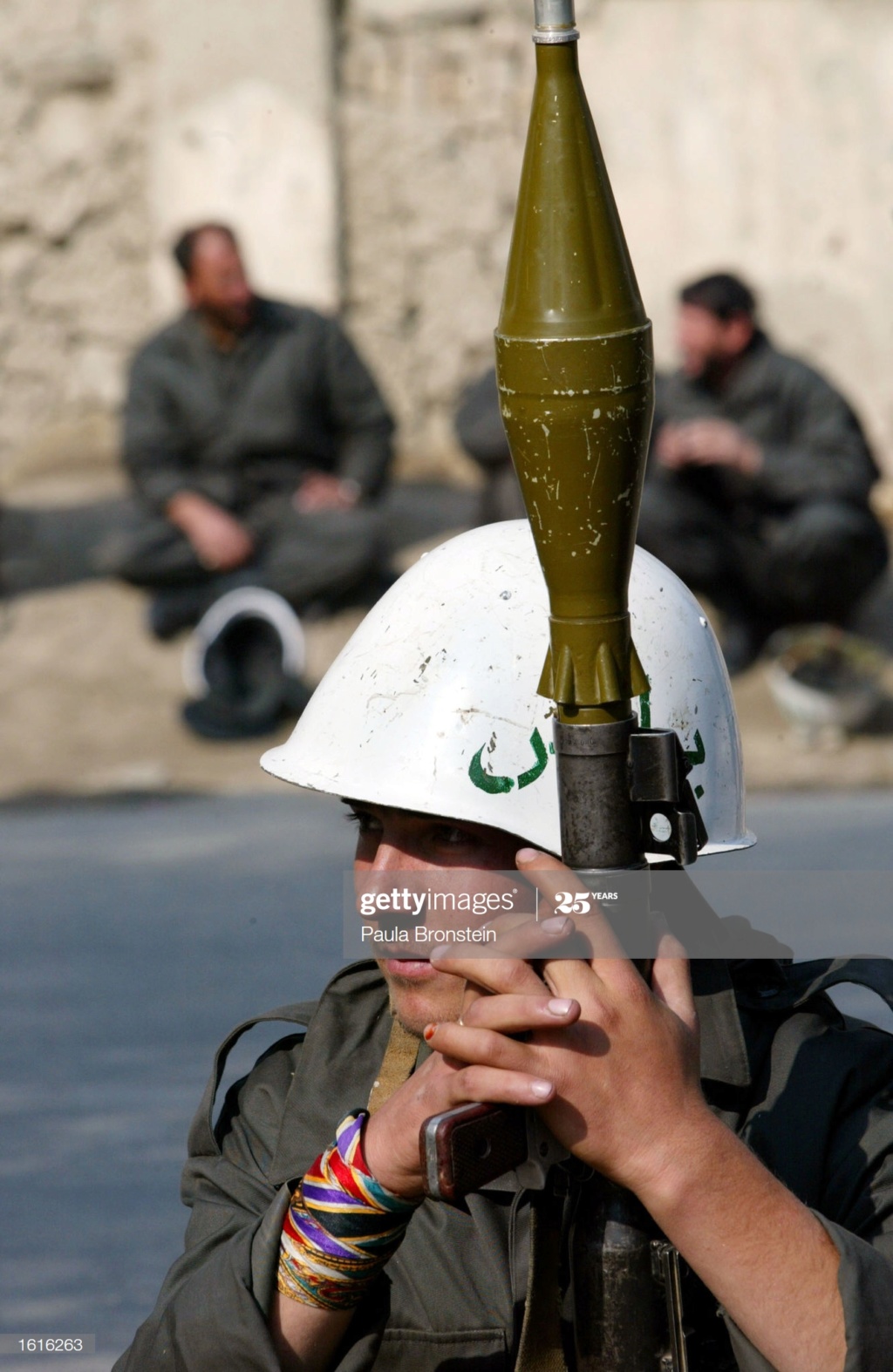
 12 November 2002
12 November 2002: KABUL, AFGHANISTAN - NOVEMBER 12: Kabul police stand guard in front of Kabul University after a protest November 12, 2002 in Kabul, Afghanistan. A crowd of over 500 students were prevented from marching on government buildings. The students were protesting against poor living conditions and the lack of food in dormitories. Some demanded the return of the bodies of those who had died. Photos by Paula Bronstein.
 12 November 2002
12 November 2002: Afghan students shout as they march through a police cordon during aprotest in Kabul November 12, 2002. Police fired in the air and usedwater cannon to prevent a protest march by hundreds of students in theAfghan capital on Tuesday after up to four students were reportedkilled in a demonstration the previous day. Photo by Bazuki Muhammad.
All three of these photos show the same script font seen on other green script helmets. The "Police" is on the wearer's right, and the "پولیس" on the wearer's left. The policeman in the second photo has his helmet on backwards, which can be confirmed by the direction of the chinstrap buckle. The third photo continues to show the replacement of the Ssh-68. 27 January 2003
27 January 2003: Afghan police on patrol in Kabul January 27, 2003. Police are checkingcars for proper registration papers as they intensify security in theAfghan capital. Afghan intelligence officers said on Sunday they hadfoiled an apparent plan to launch rocket attacks on the U.S. embassy,international peacekeepers and Kabul airport over the weekend. Photo by Erik de Castro.
This photo shows a wide variety of paint jobs. On the left is the the blocky font with "Police" on the wearer's left. To the right of him, worn backwards, is a helmet done in the style of the black text helmets. The font is the same as used on the black text helmets, as evidenced by the horizontal break in the "C", and, if worn forwards, "Police" is on the wearer's right side like on the earlier black text helmets. To the right of him is the same script font seen used in the 6 September 2002 and 12 November 2002 photos, as evidenced by the placement of the stencil breaks, and like them the Pashto "پولیس" is on the wearer's right. On the right, worn backwards, is a not previously seen large script font, which has a differently positioned first break in the "س", along with a new third break in that character, and a break between "ـیـ" and "لـ". The photo is not clear enough to see if there are differences in the "پو" other than size. If worn forward the "پولیس" would be on the wearer's left, and "Police" on the wearer's right. 8 July 2003
8 July 2003: KABUL, AFGHANISTAN - JULY 8: An Afghan man is held back by police during a demonstration against Pakistan July 8, 2003 near the Pakistan Embassy in Kabul, Afghanistan. Recent incursions by Pakistan into Afghan territory in the east have spurred 2 days of anti-Pakistan demonstrations in Kabul. Photo by Darren McCollester.
A script font in green on the wearer's left. Due to the high glare it is impossible to say for certain if this is the same as the September 2002 and 12 November 2002 script font, but my gut feeling is that it is the same. 
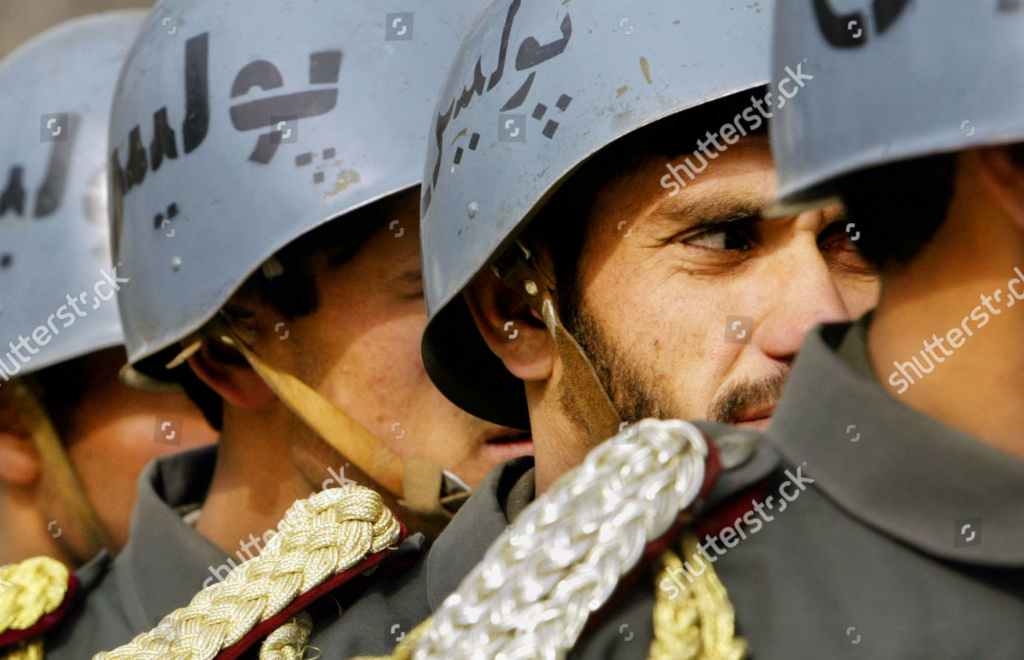
7 February 2004: AFGHAN POLICE GUARD Afghan policemen stand guard during a ceremony for the graduation of members of Afghanistan's first Crime Scene Investigators from a school run by the British police and army in Kabul, Afghanistan. The Afghan police force are an important part of national security in a country whose national Army has only 7,000 members, and they are expected to play a key role in securing elections scheduled for later this year. Photos by Ed Wray.
Once more the suspected ANP Honor Guard wear dress uniforms and grey helmets. The first photo shows exclusively blocky font, the second photo shows both the blocky font and the script font seen in the 8 September 2002 photo.  5 October 2004
5 October 2004: Afghan policemen and soldiers guard the campaign of presidential candidate Mohammed Mohaqeq in the western city of Herat, 05 October 2004. Mohaqeq is one of 17 candidates challenging Hamid Karzai for the presidency. Photo by Behrouz Mehri.
All helmets have "Police" in the blocky font on the wearer's right and thus "پولیس" on the wearer's left. It is not possible to see if these helmets have spots below the "Police" like the other blocky font right side "Police" helmet or helmets. 12 September 2004
12 September 2004: GUARD Afghan military keep the guard as Pakistani prisoners are released from Pul-e-Charki prison in Kabul on . The group of 363 Pakistani war-prisoners jailed for fighting with the Taliban were released from the Afghan capital's Pul-e-Charki jail, Sunday, a gesture meant to heal the Asian neighbors' touchy relations. The characters on helmet read "The police of prisoners, The police of ministry of justice. Photo by Emilio Morenatti.
From the translation in the caption it seems this is a unique design specifically for prison guards. It does still have breaks in the characters showing it was applied with a stencil. The guard closest to the camera helpfully has his helmet on backwards so both sides are visible in the photo. The man behind him, with his helmet on forwards, appears to have "J-K" stenciled on his helmet.  December 2005 or later
December 2005 or later: Photograph by Jalil Rezayee.
This photo was used without it's original caption or date as a stock image in a article by The Guardian. However, since these men are armed with AMD-65s, which were delivered to the Afghan Police between December 2005 and August 2006, it must have been taken December 2005 or later. It shows the first reemergence of black text on a white helmet since 20 February 2002, but unlike all previous black text helmets "پولیس" is on the wearer's right. The font is also different from earlier black text helmets, with the shape of the tail on the "و" being different and the dots of the "پـ" being closer to the rest. There is also another steel helmet with a black script "پولیس" on the right, but the shape appears not to be an Ssh-68, and the chinstrap is wider and possibly canvas. This photo also shows the continuation of markings onto more advanced helmets, what I think is a RBR F6 MK II on the left and a RBR F6 on the right. Both have "Police" in green in a new font with no stencil breaks on the wearer's right side. /b]


[b]19 September 2006: Kabul, AFGHANISTAN: Afghan police stand guard on the streets of Kabul, 19 September 2006. Three powerful blasts, which killed a total of 21 people, near the southern city of Kandahar, in Kabul and in Herat in the west were blamed on the extremist Taliban movement, which has stepped up its insurgency as foreign forces push into rebel strongholds. Afghan and international forces forged ahead with anti-Taliban offensives in the west and east of Afghanistan after the fresh wave of suicide attacks.. Photos by Farzana Wahidy
These policemen have dark helmets, the color is hard to determine, perhaps dark green, dark blue, or grey, with white Pashto text on the wearer's left side. The text is not "پولیس", it is something else. This probably means this color combination is for a specific unit of the ANP, rather than a change to the duty helmet. These men also wear camo nets over their helmets. 
 3 February 2010
3 February 2010: graduation of Afghan National Police officers in Kabul. Photos by Ton Koene.
This may be the last hurrah for the Ssh-68 in ANP service, now sporting a green band around the helmet with white text on it, "Police" on the wearer's left, and "پولیس" on the right. This may be a later duty helmet design, or this may be a marking exclusive to the training course they are graduating from. Although these men are quite well dressed, they have white helmets, and quite battered ones. I do not however think this is a contradiction to the earlier cases, as these men have blue accents, rather than the red seen in the earlier cases with the grey helmets. This further strengthens my belief that the men wearing grey helmets are ANP Honor Guard. /b]

[b]6 May 2010: Kabul - An Afghan National Civil Order Police (ANCOP) honor guard stands in formation while attending an ANCOP Officer Candidates School (OCS) graduation May 6, 2010 at the Ministry of Interior. The French Gendarmerie trained ANCOP officers are the first graduating class of ANCOP OCS. U.S. Air Force photo by Staff Sgt. Sarah Brown.
For comparison here are known ANP Honor Guard, notice the gold shoulder boards and cord, and most importantly, the red accents.